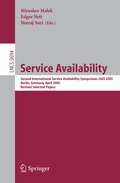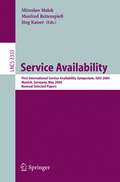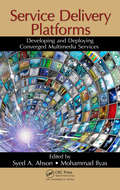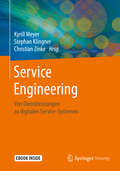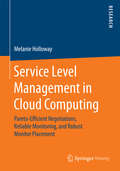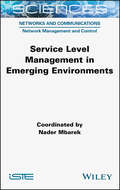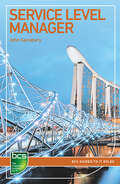- Table View
- List View
Service Availability: Second International Service Availability Symposium, ISAS 2005, Berlin, Germany, April 25-26, 2005, Revised Selected Papers (Lecture Notes in Computer Science #3694)
by Miroslaw Malek Edgar Nett Neeraj SuriService Availability: First International Service Availability Symposium, ISAS 2004, Munich, Germany, May 13-14, 2004, Revised Selected Papers (Lecture Notes in Computer Science #3335)
by Miroslaw Malek Manfred Reitenspieß Jörg KaiserService Availability: 4th International Service Availability Symposium, ISAS 2007, Durham, NH, USA, May 21-22, 2007, Proceedings (Lecture Notes in Computer Science #4526)
by Miroslaw Malek Manfred Reitenspieß Aad Van MoorselThis book constitutes the refereed proceedings of the 4th International Service Availability Symposium, ISAS 2007, held in Durham, NH, USA in May 2007. The 12 revised full papers presented are organized in topical sections on middleware, software systems, modeling and analysis, as well as model-driven development and human engineering.
Service Availability: 5th International Service Availability Symposium, ISAS 2008 Tokyo, Japan, May 19-21, 2008 Proceedings (Lecture Notes in Computer Science #5017)
by Takashi Nanya Fumihiro Maruyama Andras Pataricza Miroslaw MalekService Availability: Third International Service Availability Symposium, ISAS 2006, Helsinki, Finland, May 15-16, 2006, Revised Selected Papers (Lecture Notes in Computer Science #4328)
by Dave Penkler Manfred Reitenspiess Francis TamThis book constitutes the thoroughly refereed post-proceedings of the Third International Service Availability Symposium, ISAS 2006, held in Helsinki, Finland, in May 2006. The 19 revised full papers cover availability modeling, estimation and analysis, dependability techniques and their applications, performability: measurements and assessments, service availability standards: experience reports and futures.
Service Chain Management: Technology Innovation for the Service Business
by Christos Voudouris Gilbert Owusu Raphael Dorne David LesaintService chain management enables service organisations to improve customer satisfaction and reduce operational costs. In this book, Christos Voudouris and his BT colleagues together with experts from industry and academia present the latest innovations and technologies used to manage the operations of a service company. The viewpoints presented are based on the BT experience and on associated research and development. Service chain management is looked at both from the enterprise perspective and from the standpoints of the service professional and customer. The focus is on real-world challenges.
Service Composition for the Semantic Web
by Brahim Medjahed Athman BouguettayaService Composition for the Semantic Web presents an in-depth analysis of aspects related to semantic-enabled Web service modeling and composition. It also covers challenges and solutions to composing Web services on the semantic Web, and proposing a semantic framework for organizing and describing Web services. Service Composition for the Semantic Web describes composability and matching models to check whether semantic Web services can be combined together to avoid unexpected failures at run time, and a set of algorithms that automatically generate detailed descriptions of composite services from high-level specifications of composition requests. The book includes case studies in the areas of digital government and bioinformatics.
Service Computing: Concept, Method and Technology (Advanced Topics In Science And Technology In China Ser. #58)
by Zhaohui WuService computing is a cross-disciplinary field that covers science and technology, and represents a promising direction for distributed computing and software development methodologies. It aims to bridge the gap between business services and IT services by supporting the whole lifecycle of services innovation. Over the last ten years applications in industry and academic research have produced considerable progress and success Service Computing: Concept, Method and Technology presents the concept of service computing and a proposed reference architecture for service computing research before proceeding to introduce two underlying technologies: Web services and service-oriented architecture. It also presents the authors’ latest research findings on hot topics such as service discovery, recommendation, composition, verification, service trust, dynamic configuration and big data service. Some new models and methods are proposed including three service discovery methods based on semantics and skyline technologies, two service recommendation methods using graph mining and QoS prediction, two service composition methods with graph planning and one service verification method using π calculus and so on. Moreover, this book introduces JTang, an underlying platform supporting service computing, which is a product of the authors’ last ten years of research and development. Systematically reviews all the research on service computingIntroduces state-of-art research works on service computing and provides a road map for future directionsBridges the gap between service computing theory and practiceProvides guidance for both industry and academia
Service Delivery Platforms: Developing and Deploying Converged Multimedia Services
by Syed A. Ahson Mohammad IlyasIt is becoming increasingly important for telecom operators to be able to provide service delivery platforms (SDP) quickly and efficiently in order to improve the time-to-revenue of value-added services. Presenting a rapid architecture solution to meet this challenge, Service Delivery Platforms: Developing and Deploying Converged Multimedia Service
Service Engineering: European Research Results
by Schahram Dustdar Fei LiService engineering is increasingly posing challenges to traditional software engineering methodologies including specification, modeling, architecture, and verification, just to name a few. On the other hand, the latest advancements in software engineering are continuously leveraged in Service Engineering research, especially in the design and implementation of service-oriented systems. Several mutual impacts between service engineering and software engineering could be observed in the last decade, and many research efforts have been devoted to the field. However, in spite of the considerable efforts and significant contributions, few have attempted to summarize the research results systematically.
Service Engineering: Von Dienstleistungen zu digitalen Service-Systemen
by Kyrill Meyer Stephan Klingner Christian ZinkeDas Buch beleuchtet aktuelle Herausforderungen des Service Engineerings und zeigt dessen Entwicklung im Kontext digitaler Service-Systeme sowie Chancen und Möglichkeiten, die digitale Dienstleistungsangebote und vernetzte Lösungen bieten. Wissenschaftliche Ausführungen werden durch praxisorientierte Beispiele, welche die Anwendung der Lösungsansätze und Methoden demonstrieren, ergänzt. Damit betrachten die Autoren dieses Sammelbands einerseits die Evolution der systematischen Dienstleistungsentwicklung in Theorie und Praxis und stellen andererseits aktuelle Forschungsthemen und Entwicklungstendenzen vor. Dazu ziehen die Herausgeber Arbeiten der Partner des Forschernetzwerkes FOKUS Service Engineering heran. Die Beiträge sprechen sowohl Wissenschaftler als auch Vertreter der Praxis an.
Service Engineering: Entwicklung und Gestaltung innovativer Dienstleistungen
by K. SchneiderDie schnelle und effiziente Realisierung innovativer Dienstleistungen stellt zunehmend einen Erfolgsfaktor für die Wettbewerbsfähigkeit von Dienstleistungsunternehmen dar. Dienstleistungen werden in der Praxis jedoch oft "ad hoc", d.h. ohne systematische Vorgehensweise, entwickelt. Das Konzept des "Service Engineering" beschreibt Vorgehensweisen, Methoden und Werkzeugunterstützung für die systematische Planung, Entwicklung und Realisierung innovativer Dienstleistungen. Ziel des Herausgeberbandes Service Engineering - Entwicklung und Gestaltung innovativer Dienstleistungen ist es, Wissenschaftlern und Praktikern gleichermaßen einen Überblick über den aktuellen Kenntnisstand zum Service Engineering zu geben. Namhafte Wissenschaftler zeigen hierin Grundlagen und aktuelle Tendenzen auf. Praktiker aus unterschiedlichen Branchen stellen ihre Erfahrungen aus aktuellen Service-Engineering-Projekten vor.
Service Enterprise Integration: An Enterprise Engineering Perspective (Integrated Series in Information Systems #16)
by Cheng HsuThis book provides a systematic examination of the developing business model, service enterprise integration. It investigates the proven concepts, models, methods, and techniques in manufacturing operations and examines all aspects relevant to service productivity. Chapters written by leading researchers provide critical literature reviews, conceptual analysis, and solution-result-oriented applications.
Service Industry Databook: Understanding and Analyzing Sector Specific Data Across 15 Nations
by B. ElangoLocating empirical information on specific service industry characteristics is not an easy task, even for an individual familiar with various sources of data. This book is a quick source of information on service industry statistics across many nations of the world. The reader is introduced to finding key sources of data, building analytical ratios from diverse sources, and understanding the advantages and disadvantages of data selection methods in the service sector. The global nature of the data compiled in this book, especially an extensive coverage of the United States, makes it an invaluable resource to active researchers and stakeholders in the service industry as well as those who seek to enter it.
Service-Learning and Educating in Challenging Contexts: International Perspectives
by Timothy Murphy Jon TanService-Learning and Educating in Challenging Contexts explores the potential of service-learning identified as a way to integrate community service with academic study to enrich the on-going professional development of educators, especially in schools that are located in challenging contexts. This collection offers a further refinement of what typically comes under the remit of service-learning, switching the focus from the learning experience of the learner, to the educator and the deep and enriching professional learning opportunities that service-learning can offer. This approach to service-learning promotes collaborative practices amongst professional and in-service educators, and encourages an integration of theory and practice. The international contributors use their own experiences as well as current research to provide a thorough exploration of service-learning from national and international perspectives.
Service-Learning and Educating in Challenging Contexts: International Perspectives
by Timothy Murphy Jon E. C. TanService-Learning and Educating in Challenging Contexts explores the potential of service-learning identified as a way to integrate community service with academic study to enrich the on-going professional development of educators, especially in schools that are located in challenging contexts. This collection offers a further refinement of what typically comes under the remit of service-learning, switching the focus from the learning experience of the learner, to the educator and the deep and enriching professional learning opportunities that service-learning can offer. This approach to service-learning promotes collaborative practices amongst professional and in-service educators, and encourages an integration of theory and practice. The international contributors use their own experiences as well as current research to provide a thorough exploration of service-learning from national and international perspectives.
Service-Learning in the Computer and Information Sciences: Practical Applications in Engineering Education
by Brian A. NejmehOffering a truly global perspective, this book serves as a road map for service-learning partnerships between information science and nonprofit organizations. It introduces for the first time an essential framework for service learning in CIS, addressing both the challenges and opportunities of this approach for all stakeholders involved: faculty, students, and community nonprofit organizations (NPOs), both domestic and abroad. This volume outlines numerous examples of successful programs from around the world, presenting practical working models for implementing joint projects between NPOs and academia.
Service-Learning in the Computer and Information Sciences: Practical Applications in Engineering Education
by Brian A. NejmehOffering a truly global perspective, this book serves as a road map for service-learning partnerships between information science and nonprofit organizations. It introduces for the first time an essential framework for service learning in CIS, addressing both the challenges and opportunities of this approach for all stakeholders involved: faculty, students, and community nonprofit organizations (NPOs), both domestic and abroad. This volume outlines numerous examples of successful programs from around the world, presenting practical working models for implementing joint projects between NPOs and academia.
Service Level Agreements for Cloud Computing
by Philipp Wieder Joe M. Butler Wolfgang Theilmann Ramin YahyapourService Level Agreements for Cloud Computing provides a unique combination of business-driven application scenarios and advanced research in the area of service-level agreements for Clouds and service-oriented infrastructures. Current state-of-the-art research findings are presented in this book, as well as business-ready solutions applicable to Cloud infrastructures or ERP (Enterprise Resource Planning) environments. Service Level Agreements for Cloud Computing contributes to the various levels of service-level management from the infrastructure over the software to the business layer, including horizontal aspects like service monitoring. This book provides readers with essential information on how to deploy and manage Cloud infrastructures. Case studies are presented at the end of most chapters. Service Level Agreements for Cloud Computing is designed as a reference book for high-end practitioners working in cloud computing, distributed systems and IT services. Advanced-level students focused on computer science will also find this book valuable as a secondary text book or reference.
Service Level Management in Cloud Computing: Pareto-Efficient Negotiations, Reliable Monitoring, and Robust Monitor Placement
by Melanie HollowayMelanie Holloway explores a cloud broker offering service level agreement negotiation and monitoring as a service to consumers. She proposes a negotiation mechanism, which enables the achievement of economically efficient agreements, and an approach for reliable consumer side availability monitoring in conjunction with strategies for robust monitor placement. The author addresses the loss of control of consumers over critical aspects, specifically quality of service, when using services from the cloud.Basically, the cloud computing paradigm places the responsibility for resource management on the provider side. Hence, the control over cloud service performance is very limited on the consumer side.
Service Level Management in Emerging Environments
by Nader MbarekNetworks are now embedded in daily life thanks to smaller, faster, inexpensive components that are more powerful and increasingly connected. Parallel to this quantitative explosion of communication networks, technology has become more complex. This development comes with challenges related to management and control, and it has become necessary to manage the service level demands of the client to which the service provider commits. Different approaches to managing one or more service level components in different emerging environments are explored, such as: the Internet of Things, the Cloud, smart grids, e-health, mesh networking, D2D (Device to Device), smart cities and even green networking. This book therefore allows for a better understanding of the important challenges and issues relating to Quality of Service (QoS) management, security and mobility in these types of environment.
Service Level Management in Emerging Environments
by Nader MbarekNetworks are now embedded in daily life thanks to smaller, faster, inexpensive components that are more powerful and increasingly connected. Parallel to this quantitative explosion of communication networks, technology has become more complex. This development comes with challenges related to management and control, and it has become necessary to manage the service level demands of the client to which the service provider commits. Different approaches to managing one or more service level components in different emerging environments are explored, such as: the Internet of Things, the Cloud, smart grids, e-health, mesh networking, D2D (Device to Device), smart cities and even green networking. This book therefore allows for a better understanding of the important challenges and issues relating to Quality of Service (QoS) management, security and mobility in these types of environment.
Service Level Manager: Careers in IT service management (Bcs Guides To It Roles Ser.)
by John SansburyThe role of service level manager is a critical one in that the agreements negotiated with customers should inform the activities of the service provider. This book aims to help those whose role is to establish, negotiate, manage or update service level agreements and to use these as the basis of continual service improvement. It covers areas such as purpose, required skills, responsibilities, interface and career progression as well as tools, standards and frameworks related to the role.
Service Level Manager: Careers in IT service management (Bcs Guides To It Roles Ser.)
by John SansburyThe role of service level manager is a critical one in that the agreements negotiated with customers should inform the activities of the service provider. This book aims to help those whose role is to establish, negotiate, manage or update service level agreements and to use these as the basis of continual service improvement. It covers areas such as purpose, required skills, responsibilities, interface and career progression as well as tools, standards and frameworks related to the role.
Service Management For Dummies
by Judith S. Hurwitz Robin Bloor Marcia Kaufman Fern HalperA plain-English guide to managing IT from the customer's perspective Practical guidance on delivering and managing IT so that it meets the multiple needs and demands of a company and its customers and end-users–both inside and outside the organization–is hard to come by; this accessible book takes a common-sense approach that explains exactly what IT services are and how to fit them most effectively into a business Topics include setting a framework, keeping costs down, improving efficiency, and maintaining standards and best practices This concept of how IT should be wired specifically into the goals and need of the company and its customers is part of a broader picture that includes ITIL, BPM, SOA, and Six Sigma
